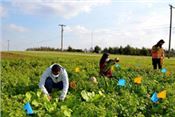Innovative Class Explores Cover Crops’ Place In Agricultural Systems

UK students from left: Osei Jordan, Sapana Pandey and Susanne Deeb harvest biomass off their cover crop plots at UK's Horticultural Research Farm in Lexington. The students are part of a cover crops and agroecosystems class co-taught by UK weed scientist Erin Haramoto.
Photo by Katie Pratt, UK agricultural communications.
KATIE PRATT
LEXINGTON, KENTUCKY
Cover crops can have many benefits for farmers over time, but they also can be challenging for growers to effectively manage. University of Kentucky students are a part of a multidisciplinary class studying how cover crops can fit into diverse agricultural systems across the United States.
Nearly 80 college students from seven U.S. universities are participating in a class called cover crops and agroecosystems. The class is organized and taught by eight university instructors, including UK weed scientist Erin Haramoto. The hybrid class includes in-person exercises and virtual discussion and education. The students study cover crops in agricultural systems including corn, soybeans and specialty crops.
“Nationwide, there has been a large increase in cover crop use over the past few years,” said Haramoto, an associate professor in the UK College of Agriculture, Food and Environment. “Farmers are interested in using them, but there are some real challenges that limit their adoption. This class is studying how to implement and manage cover crops to maximize their benefits and minimize their negative aspects.”
UK has seven undergraduate and graduate students participating in the class. Other students are from Clemson University, University of Maryland, University of New Hampshire, Cornell University, Michigan State University and University of Nebraska, Lincoln.
The class takes a multidisciplinary approach to cover crop education.
Students learn about the ways cover crops affect the soil, insects, diseases and weeds. They also learn about cover cropping economics and ways to support farmers who use them.
During Friday Zoom discussions, instructors divide the students into small groups to discuss what they have found during their exercises that week.
“On any given Friday, I’m probably talking to students from three or four different universities,” said Viktor Halmos, a UK graduate student studying entomology from Lexington. “It is interesting to hear the different rotations in their states, what soil types they are working with and what sort of weather impacts that they have.”
One of the most recent in-person exercises required the students to develop their own cover crop mixture, plant and harvest it. During the harvest, they noted insects, weeds, earthworms and measured plant biomass above ground and root biomass in the soil.
The class compared their results to students in other states. Some of the preliminary data showed most states had similar above-ground biomass. The UK students’ cover crop mixtures suppressed weeds, and they found a lot of different insects within their plots. Kentucky and South Carolina had the most microbial activity in their plots, which Haramoto said was expected because those two states are the warmest and wettest in the class.
In prior class meetings, the instructors encouraged the students to work with each other to solve problems they will potentially face one day as agricultural industry professionals.
“We do a lot of application work,” said Susanne Deeb, a UK senior with an individualized curriculum major in agriculture from Roswell, Georgia. “We just spent three weeks building a crop rotation for a county in Nebraska that no one in my group had ever been to before. We learned that we are going to be scientists in places that we may know nothing about, and we are going to have to figure things out like crop rotations.”
The class is part of a larger five-year, $10 million grant the U.S.
Department of Agriculture awarded to a multidisciplinary group of researchers led by scientists at North Carolina State University in 2019. The researchers are trying to learn more about cover crops and ways they can increase their usage among farmers. Haramoto is also involved in research efforts and is studying pest management in cover crops. UK assistant professor Hanna Poffenbarger is also part of the team and is conducting research on nitrogen dynamics.
This material is based upon work that is supported by the National Institute of Food and Agriculture, U.S. Department of Agriculture, under award number 2019-1507-05. Any opinions, findings, conclusions or recommendations expressed in this publication are those of the author(s) and do not necessarily reflect the view of the Department of Agriculture. ∆